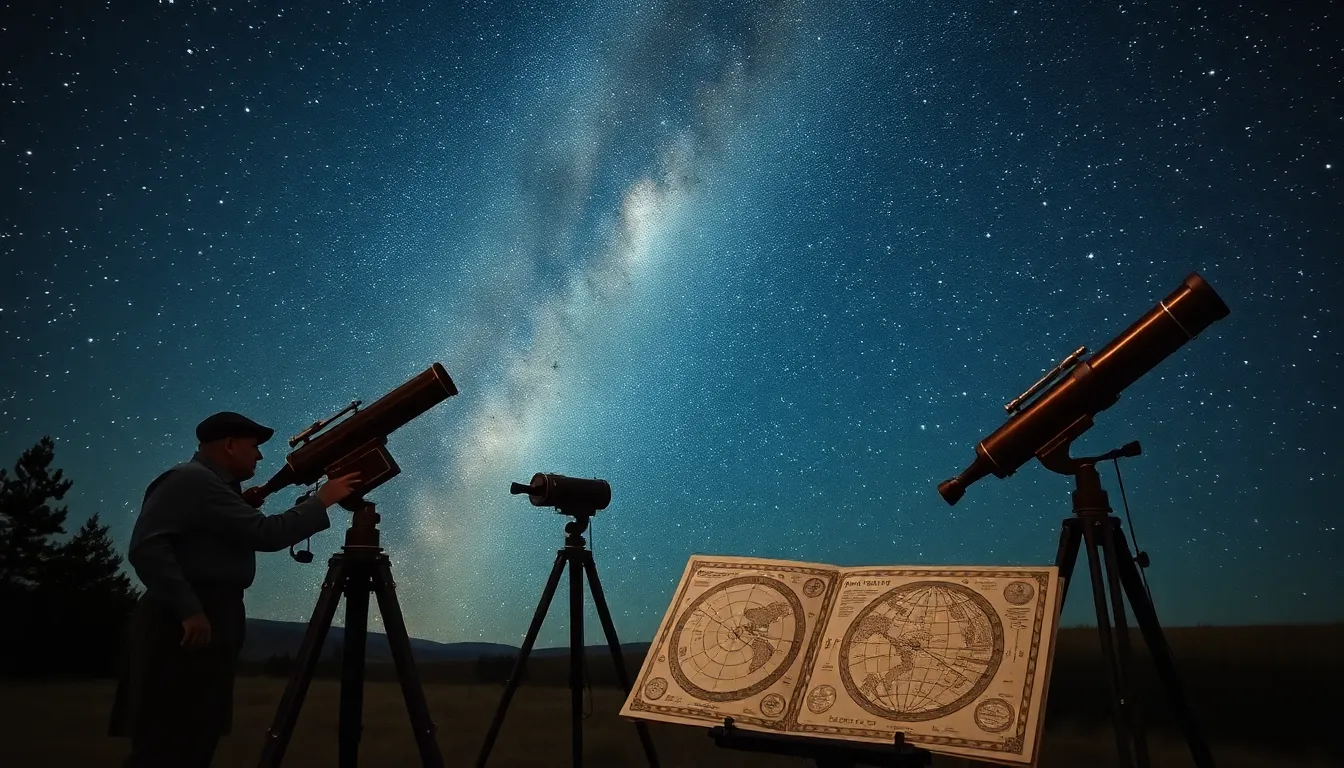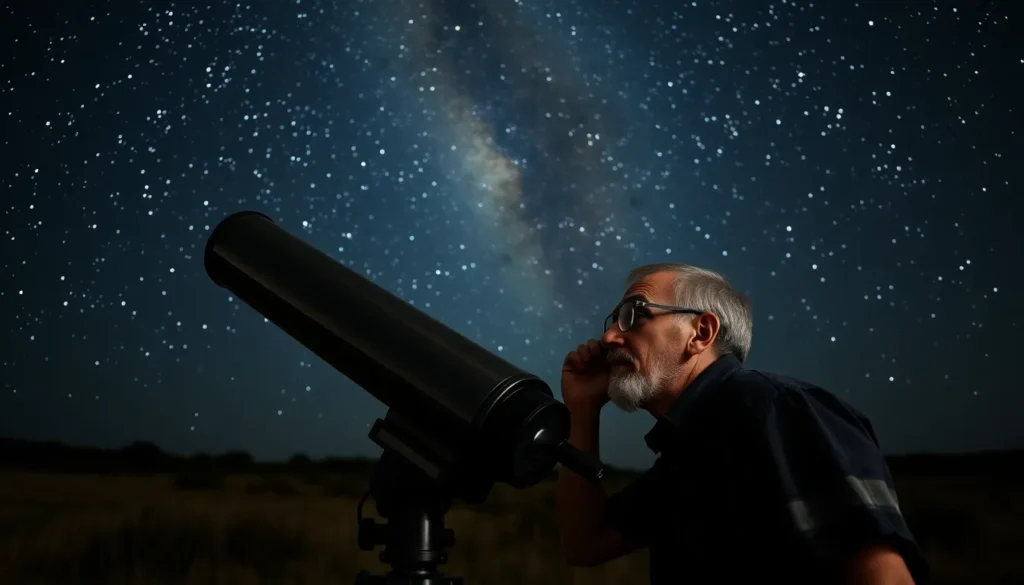Table of Contents
ToggleEver gazed up at the night sky and wondered if those twinkling stars are just celestial fireflies having a party? Cosmic observation isn’t just for the nerdy astronomers; it’s an invitation to explore the universe’s greatest mysteries. From the dazzling dance of planets to the awe-inspiring beauty of distant galaxies, there’s a whole lot more up there than just a few shiny dots.
Overview of Cosmic Observation
Cosmic observation reveals the vast beauty of the universe. People observe celestial bodies, phenomena and events constantly, experiencing the thrill of discovery. Telescopes provide optimal views of distant galaxies, while binoculars enable stargazers to explore the night sky.
Astronomical phenomena, such as meteor showers and supernovae, captivate observers. These events often occur at specific times throughout the year, making them accessible to the public. Engaging with cosmic observation enhances understanding of the greater cosmos and increases appreciation for celestial mechanics.
Many organizations offer resources for amateur astronomers. Websites like NASA provide updated information on observatories, discoveries and upcoming celestial events. Furthermore, local astronomy clubs organize viewing events, fostering community involvement and shared experiences.
Knowledge of cosmic observation encompasses more than mere star-gazing. The study of planets, moons and asteroids expands one’s perspective of the solar system. Understanding orbital mechanics, light years and the speed of light assists in grasping the scale of the universe and its vastness.
Educational institutions increasingly incorporate cosmic observation into curricula. Schools often encourage students to participate in astronomy nights, allowing firsthand experience with telescopes and observation techniques. This practical knowledge not only fosters interest in STEM fields but builds lifelong skills in scientific inquiry and observation.
Observing cosmic phenomena inspires curiosity and wonder. Each glance at the night sky presents an opportunity for reflection on the mysteries that lie beyond Earth’s atmosphere. Engaging in cosmic observation provides access to the universe’s secrets, sparking interest and igniting the imagination of current and future generations.
Historical Perspectives on Cosmic Observation

Cosmic observation’s history reflects humanity’s quest to understand the universe. From ancient civilizations to modern technology, each era shaped our approach to the night sky.
Ancient Civilizations and Astronomy
Ancient civilizations advanced astronomy significantly. The Babylonians meticulously recorded celestial movements. Greeks built elaborate models to explain planetary orbits, while the Mayans created precise calendars based on lunar cycles. Egyptians associated stars with their gods and constructed pyramids aligned with celestial bodies. Observations often served practical purposes, aiding agricultural cycles and navigation. Through these efforts, a foundation for future celestial study emerged, highlighting connections between humanity and the cosmos.
The Evolution of Telescopes
Telescopes revolutionized cosmic observation. In 1608, Hans Lippershey developed the first practical telescope, enabling unprecedented views of celestial bodies. Galileo Galilei adopted this technology to observe moons of Jupiter and the phases of Venus, expanding comprehension of the solar system. The 18th century saw the introduction of refracting telescopes, further enhancing astronomers’ capabilities. In the 20th century, Edwin Hubble’s advancements in reflecting telescopes expanded the observable universe immensely. Innovations like radio, infrared, and space telescopes continue to push boundaries, allowing detailed exploration of phenomena previously beyond reach.
Modern Techniques in Cosmic Observation
Advancements in technology have transformed cosmic observation, enhancing how individuals explore the universe. Modern techniques focus on both ground-based and space-based observatories.
Ground-Based Observatories
Ground-based observatories leverage Earth’s atmosphere to study celestial phenomena. These facilities utilize advanced telescopes equipped with adaptive optics systems to minimize atmospheric distortions. Observatories like the Mauna Kea Observatories in Hawaii offer high-altitude locations, reducing light pollution and increasing visibility of distant stars and galaxies. Some observatories specialize in specific wavelengths, such as radio or infrared, allowing for comprehensive investigations of cosmic events. Instruments like the Large Synoptic Survey Telescope (LSST) will conduct wide-field surveys, contributing to discoveries about transient events like supernovae and asteroid tracking. Increased collaboration among institutions enhances data collection and analysis, leading to richer insights into cosmic structures and dynamics.
Space-Based Observatories
Space-based observatories orbit beyond Earth’s atmosphere, providing clarity in cosmic observation. The Hubble Space Telescope, launched in 1990, revolutionized our understanding of deep space with its unparalleled image quality. Other missions, such as the James Webb Space Telescope (JWST), promise to uncover insights into the formation of stars and galaxies by observing infrared light emitted from distant objects. Unique positioning outside the atmosphere eliminates light distortion, enabling clear observations across various wavelengths. Space observatories enhance collaboration between scientists and promote extensive international research opportunities. By deploying advanced sensors and instruments, scientists gather data on exoplanets and cosmic phenomena to deepen knowledge of the universe.
Importance of Cosmic Observation
Cosmic observation serves as a gateway to understanding the universe’s mysteries. Engaging with the night sky reveals insights that impact science and humanity.
Understanding the Universe’s Origin
Cosmic observation sheds light on the universe’s beginnings. Astronomers analyze cosmic background radiation, providing evidence of the Big Bang. What’s more, studying ancient light from distant galaxies helps reconstruct the early universe’s conditions. Discoveries about cosmic inflation refine existing models, enhancing comprehension of cosmic evolution. Collaborations across research institutions foster innovative theories about dark matter and energy.
Discovering Celestial Bodies
Celestial bodies like planets, moons, and asteroids unveil secrets of the solar system. Observers utilize advanced instruments to track their movements, revealing patterns and anomalies. Plateaus of information emerge as telescopes capture real-time data, aiding in cataloging these objects. Discoveries of exoplanets expand understanding of potential life beyond Earth. Engaging in cosmic observation fosters appreciation for the vastness and complexity of the universe.
Challenges in Cosmic Observation
Cosmic observation presents various challenges that affect how individuals and researchers explore the universe.
Light Pollution and Its Effects
Light pollution significantly hampers astronomical observations. Urban environments, filled with excessive artificial lighting, obscure the visibility of faint celestial objects. Astronomers often struggle to find dark locations, as many ideal spots lie far from cities. In recent years, communities have begun to address this issue by implementing programs that reduce light emissions. Efforts include shielding outdoor lighting and utilizing warmer color temperatures. These initiatives enhance night sky visibility and foster greater interest in astronomy. With better viewing conditions, observers can detect more celestial phenomena and appreciate the universe’s beauty.
Technical Limitations
Technical limitations also pose challenges in cosmic observation. Equipment can be expensive, making it difficult for amateur astronomers to access high-quality telescopes. While advancements in technology improve observations, not all instruments provide the necessary resolution. Amateur astronomers often rely on mobile applications to track celestial events, but these tools sometimes lack real-time data. Collaboration among research institutions often leads to breakthroughs, yet funding constraints limit the development of new technologies. Increased support for innovative astronomical tools encourages wider participation in cosmic observation, paving the way for future discoveries.
Future of Cosmic Observation
The future of cosmic observation looks promising, with innovations shaping new possibilities.
Upcoming Technologies
Innovative technologies are set to revolutionize cosmic observation. The next generation of telescopes, such as the Extremely Large Telescope (ELT), promises improved resolution and sensitivity. Advanced imaging techniques harness artificial intelligence to filter data, enhancing detection capabilities of faint celestial objects. Space-based observatories like the Roman Space Telescope will survey the universe more efficiently, providing insights into dark energy and exoplanets. Satellite systems equipped with high-resolution cameras will offer real-time monitoring of cosmic events, enabling faster responses to transient phenomena. Collaborative projects worldwide will likely facilitate data sharing, enriching the understanding of cosmic processes.
Potential Discoveries
Potential discoveries in cosmic observation could reshape knowledge of the universe. Astronomers anticipate finding more exoplanets, particularly those in habitable zones, broadening the search for extraterrestrial life. Studies of cosmic background radiation may lead to new insights into the Big Bang and the evolution of the universe. Impactful discoveries might surface from investigating dark matter and energy, providing clues to the universe’s composition. Monitoring asteroids and comets will help assess potential threats to Earth. Advances in observational capabilities can unravel the mysteries of black holes, offering deeper comprehension of their roles in galaxy formation.
Cosmic observation opens a gateway to the universe’s wonders that anyone can explore. With advancements in technology and community resources, the night sky becomes more accessible than ever. As individuals engage in this pursuit, they not only discover celestial phenomena but also cultivate curiosity and a deeper appreciation for science.
The future promises even greater revelations as innovative tools and techniques emerge. As humanity continues its quest for knowledge, cosmic observation stands as a testament to our innate desire to understand the cosmos and our place within it. Engaging with the universe inspires generations to look up and wonder.





